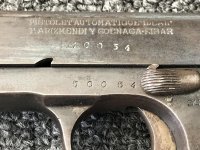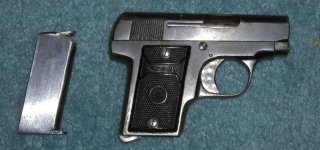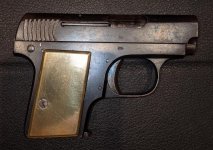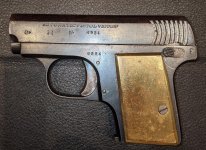You are using an out of date browser. It may not display this or other websites correctly.
You should upgrade or use an alternative browser.
You should upgrade or use an alternative browser.
Unknown .25 ACP pistol
- Thread starter jjroth63
- Start date
Register to hide this ad
DWalt
Member
There is an enormous variety of .25 ACP pistols which were made in various European countries (including Spain) during the period between WWI and WWII. And nearly all of them are simply slight design variations of the original Colt/FN Model 1908 Vest Pocket .25 pistol. Aside from some higher quality pistols made in Germany and Belgium by makers such as FN, Walther, and Mauser, and of course Colt in the USA, most of the .25 pistols have relatively modest value, and even then only if they are complete, fully functional, and in like-new condition. They have little to no collector desirability and repair parts will be difficult, if not impossible, to find if needed.
Last edited:
MCorps0311
US Veteran
Just a little mouse gun.
THE PILGRIM
Member
The Book of Pistols and Revolvers by W. H. B. Smith has a large chapter on 25s.
here's some more info for you: Arizmendi, Francisco From 1886 to 1914 in Eibar, Spain. In 1914 the name was changed to Francisco Arizmendi. The earlier company was best known for their revolvers, while after 1914 the emphasis was changed to pistols, and they were produced under many trade names.
The name Arizmendi has long been known in the Spanish arms industry, the firm Arizmendi y Goenaga having been established in 1886. Up to 1913-14, twenty-seven catalogs had been issued. While the earlier years had been devoted to the manufacture of revolvers it appears that early in this century the firm began to take interest in the rapidly developing popularity of the automatic pistol. The Walman pistols originated around 1907-09 and were based on patents issued to the firm.
Some time around 1914, or shortly thereafter, the firm name was changed to Francisco Arizmendi. The 1913-14 catalog (No. 27) has the name „Francisco Arizmendi (Sucesor )" printed below the name F. Arizmendi y Goenaga and in different ink.
The principal automatics for which this firm is known are the Walman, Victor, Ydeal, and Singer. The name Victor was, for some unknown reason, dropped and the name Singer substituted therefor. Later a new model of the Singer was brought out, in which were incorporated improvements made in the Walman and Ideal models. This improvement consisted particularly in a chamber cartridge indicator which enabled one to ascertain, by sight or touch, whether there was a cartridge in the chamber.
The new Singers were considerably heavier than their predecessor, the Victor. The weights of the 6.35 and 7.65 mm. Victors were 265 and 530 grams, respectively, whereas the weights of the corresponding Singers were 320 and 630 grams, without magazines. The Ydeal was the lightest of the series. As originally made, the Ydeal (then made in 6.35 mm. only) weighed 240 grams as compared to 270 grams for the 6.35 mm. Walman and 265 grams for the 6.35 mm. Victor.
All of these pistols were of a simple blowback type, based on the Browning. They had thumb safeties, located at the rear of the frame in each case, and they had magazine safeties which prevented accidental discharge when the magazine was removed. None were provided with grip safeties.
Both Arizmendi y Goenaga and successor, Francisco Arizmendi, produced pistols under the name „Kaba Spezial." The original Kaba Spezial was made by August Menz in Suhl, Germany, and sold by Karl Bauer of Berlin, from whose name the name Kaba was derived. The Kaba Spezials as made by Arizmendi y Goenaga and by Francisco Arizmendi were not copies of the German pistol. The latter had the forward part of the slide cut away, exposing the entire length of the barrel, which was not the case in the Spanish-made Kabas. The two Spanish pistols were not alike in some respects and appear not to have been made with the same tools. The monogram on the grip plates of the specimen made by Francisco Arizmendi, bearing the words KABA SPEZIAL, is almost an exact copy of the monogram on the original German pistol.
During World War I a pistol of the Ruby type was made by this firm for the French Army. Both names, Arizmendi y Goenaga and (later) Francisco Arizmendi, are listed as manufacturers of such pistols. Whether such production was under license from Gabilondos y Urresti, to whom the Ruby patent had been issued in 1914, is not known. (See Gabilondo Pistols for a discussion of the Ruby pistols.)
The firm ceased production after h Spanish Civil ended in 1939, as they were among the many firms denied permission to do so after the Spanish revolution.
Not all Spanish made pistols are junk, Star and Llama were well made. Star even produced pocket pistols for Colt in the 60's and 70's.
25 may be a pip squeak, but I sure as hell won't want to get shot with one! Especially at close range. I have meet a few victim's of 25's and they were none too happy about getting shot. Some couldn't respond!
I don't believe those grips are original to the gun.
Hope this info is informtive.
The name Arizmendi has long been known in the Spanish arms industry, the firm Arizmendi y Goenaga having been established in 1886. Up to 1913-14, twenty-seven catalogs had been issued. While the earlier years had been devoted to the manufacture of revolvers it appears that early in this century the firm began to take interest in the rapidly developing popularity of the automatic pistol. The Walman pistols originated around 1907-09 and were based on patents issued to the firm.
Some time around 1914, or shortly thereafter, the firm name was changed to Francisco Arizmendi. The 1913-14 catalog (No. 27) has the name „Francisco Arizmendi (Sucesor )" printed below the name F. Arizmendi y Goenaga and in different ink.
The principal automatics for which this firm is known are the Walman, Victor, Ydeal, and Singer. The name Victor was, for some unknown reason, dropped and the name Singer substituted therefor. Later a new model of the Singer was brought out, in which were incorporated improvements made in the Walman and Ideal models. This improvement consisted particularly in a chamber cartridge indicator which enabled one to ascertain, by sight or touch, whether there was a cartridge in the chamber.
The new Singers were considerably heavier than their predecessor, the Victor. The weights of the 6.35 and 7.65 mm. Victors were 265 and 530 grams, respectively, whereas the weights of the corresponding Singers were 320 and 630 grams, without magazines. The Ydeal was the lightest of the series. As originally made, the Ydeal (then made in 6.35 mm. only) weighed 240 grams as compared to 270 grams for the 6.35 mm. Walman and 265 grams for the 6.35 mm. Victor.
All of these pistols were of a simple blowback type, based on the Browning. They had thumb safeties, located at the rear of the frame in each case, and they had magazine safeties which prevented accidental discharge when the magazine was removed. None were provided with grip safeties.
Both Arizmendi y Goenaga and successor, Francisco Arizmendi, produced pistols under the name „Kaba Spezial." The original Kaba Spezial was made by August Menz in Suhl, Germany, and sold by Karl Bauer of Berlin, from whose name the name Kaba was derived. The Kaba Spezials as made by Arizmendi y Goenaga and by Francisco Arizmendi were not copies of the German pistol. The latter had the forward part of the slide cut away, exposing the entire length of the barrel, which was not the case in the Spanish-made Kabas. The two Spanish pistols were not alike in some respects and appear not to have been made with the same tools. The monogram on the grip plates of the specimen made by Francisco Arizmendi, bearing the words KABA SPEZIAL, is almost an exact copy of the monogram on the original German pistol.
During World War I a pistol of the Ruby type was made by this firm for the French Army. Both names, Arizmendi y Goenaga and (later) Francisco Arizmendi, are listed as manufacturers of such pistols. Whether such production was under license from Gabilondos y Urresti, to whom the Ruby patent had been issued in 1914, is not known. (See Gabilondo Pistols for a discussion of the Ruby pistols.)
The firm ceased production after h Spanish Civil ended in 1939, as they were among the many firms denied permission to do so after the Spanish revolution.
Not all Spanish made pistols are junk, Star and Llama were well made. Star even produced pocket pistols for Colt in the 60's and 70's.
25 may be a pip squeak, but I sure as hell won't want to get shot with one! Especially at close range. I have meet a few victim's of 25's and they were none too happy about getting shot. Some couldn't respond!
I don't believe those grips are original to the gun.
Hope this info is informtive.
parts for victor 25acp francisco arizmendi, eibar, spain. - Bing
Gives a nice photo of the original grips. These are on the Singer which replaced the Victor name. Numrich has some parts, also check wih Jack First.
A Google search will give you more: parts for victor 25acp francisco arizmendi, eibar, spain.
Gives a nice photo of the original grips. These are on the Singer which replaced the Victor name. Numrich has some parts, also check wih Jack First.
A Google search will give you more: parts for victor 25acp francisco arizmendi, eibar, spain.
Absalom
SWCA Member, Absent Comrade
.....
The name Arizmendi has long been known in the Spanish arms industry, .....
During World War I a pistol of the Ruby type was made by this firm for the French Army. Both names, Arizmendi y Goenaga and (later) Francisco Arizmendi, are listed as manufacturers of such pistols. Whether such production was under license from Gabilondos y Urresti, to whom the Ruby patent had been issued in 1914, is not known.....
Nice write-up!
The Arizmendi family appears to have had several members in the gun trade at the same time; a 1914 listing of Eibar gun makers I have includes four firms containing the name, Arizmendi y Zulaica, Leon Arizmendi, Isidro Arizmendi e Hijos, and Arizmendi y Goenaga, all revolver manufacturers; only the last one also made auto pistols.
Arizmendi y Goenaga were one of the larger Ruby manufacturers, with 125 employees in 1914, even though they were not one of the original four firms subcontracted by Gabilondo to help fill their French contracts. Serial numbers up to 80,000 are documented; I have #50054.
Attachments
LVSteve
Member
I don't think anybody really knows how many variations of these .25 ACP and .32 ACP caliber vest pocket pistols were made. Below is mine, no maker's ID, just a serial number. By the looks of the backstrap/frame interface it was made made by fans of the cubist art movement.

Attachments
DWalt
Member
I am no way an expert on Spanish guns (aside from once owning several of them), but I have been surprised by the large number of gun manufacturers which were located in Spain (mainly in the Basque region) during the first half of the 20th Century. I have read that there were many small "job shops" also there, cottage industries (or sweat shops) which existed for the purpose of manufacturing parts and components used by the larger gun manufacturers. I wonder what it was about that region (and the Basque people) which resulted in its becoming a large firearms manufacturing center which was not known for much else?
Last edited:
I'm not exactly sure why vest pocket .25 ACP pistols were so popular around the world but the deep concealment ability must have had something to do with it. Even well into the 20th century they were popular, whether older Colts or Brownings or later model Jennings and Ravens, etc.
I carried this one from time to time, mostly in Florida after I brought it to my mother's so that I would have a gun there without having to carry one on the plane every time I visited. Then it came home again....
I will note that it is solely an up close and personal weapon - at distance I have no idea where the bullets go.
Made in Opotschno, German occupied Czechoslovakia, 1944:

Beretta, of course, made some of the best mouseguns ever, a little bit larger than the vest pocket models. You can see the difference here:

The "Baby Browning" is actually a faithful replica made by PSP/Precision Small Parts. Now out of business. No small wonder. Many of their guns, including this one, are jammamatics. Gorgeous guns but useless.

So, these little guns are cool and they can be deadly but they make better back up guns than primary guns if you have a choice.
Even the little Seecamp .32 should only be a backup. YMMV as always.

Obviously, I have to admit being a mouse gun fan.
I carried this one from time to time, mostly in Florida after I brought it to my mother's so that I would have a gun there without having to carry one on the plane every time I visited. Then it came home again....
I will note that it is solely an up close and personal weapon - at distance I have no idea where the bullets go.
Made in Opotschno, German occupied Czechoslovakia, 1944:

Beretta, of course, made some of the best mouseguns ever, a little bit larger than the vest pocket models. You can see the difference here:

The "Baby Browning" is actually a faithful replica made by PSP/Precision Small Parts. Now out of business. No small wonder. Many of their guns, including this one, are jammamatics. Gorgeous guns but useless.

So, these little guns are cool and they can be deadly but they make better back up guns than primary guns if you have a choice.
Even the little Seecamp .32 should only be a backup. YMMV as always.

Obviously, I have to admit being a mouse gun fan.
Last edited:
Absalom
SWCA Member, Absent Comrade
.... I wonder what it was about that region (and the Basque people) which resulted in its becoming a large firearms manufacturing center which was not known for much else?
To save myself some typing, here’s a quote from a country study:
“The northern coast and the Basque region were centers of basic industry because of their coal and iron ore deposits and their port facilities, used for raw material imports. Spain's major iron and steel works were located in the northern region, as were a number of engineering industries, shipbuilding facilities, and chemical plants.”
My brother spent a few years as a consulting engineer building industrial plants in the Basque country, so I’m a bit familiar even though I was never there myself.
Do not imagine the region, like some people do, as some European equivalent of the Khyber Pass region dominated by little workshops assembling guns by hand (although these did exist pre-WW II). This was a developed industrial base by the 20th century; steel-making and the weapons industry there goes back to the Middle Ages.
Help reassembling the Arizmendi Victor
Hi,
Thanks for all of the great information, I have not seen another gun exactly the same as mine. I know that the original grips have been replaced with brass slabs.
Now that it has been identified, here are some photos.
The bad news is that I took it apart and I cannot get it to work. I stripped it all the way down to the bare frame, ultrasonically cleaned, lubed and reassembled, but it is not together correctly. The trigger bar does not seem to be connected to anything.
Who can help me? Are there any diagrams available?
I can take it apart again and show the parts that I have.
Thanks,
John
Hi,
Thanks for all of the great information, I have not seen another gun exactly the same as mine. I know that the original grips have been replaced with brass slabs.
Now that it has been identified, here are some photos.
The bad news is that I took it apart and I cannot get it to work. I stripped it all the way down to the bare frame, ultrasonically cleaned, lubed and reassembled, but it is not together correctly. The trigger bar does not seem to be connected to anything.
Who can help me? Are there any diagrams available?
I can take it apart again and show the parts that I have.
Thanks,
John
Attachments
Last edited:
Hi, Your pistol from Opotschno looks the most similar to my Victor. Would you please send me some photos of it disassembled? If you could remove the slide, grips and magazine, it might help me figure out my problem.
Thanks,
John
Thanks,
John
OLDSTER
Member
Similar threads
- Replies
- 13
- Views
- 948
- Replies
- 38
- Views
- 2K
Latest posts
-
-
-
-
Anybody recognize these grips?
- Latest: Kansasgunner
-
-
-
-
-
-
-
-
Sharing photos of my beautiful Bleile engraved Model 63
- Latest: Thaddeus Beauregard
-





